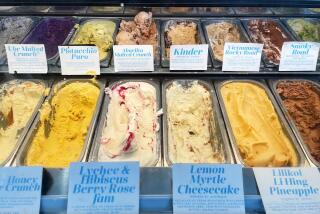Les BRULEES
- Share via
Although newly popular, Creme Brulee is actually older than the Victorian setting in which the ramekins of custard are shown. The oldest known recipe dates back to England in the 17th Century, and the dessert was known in California almost 100 years ago. The traditional version consists of rich custard topped with a layer of sugar that is melted under the broiler. When cooled, the sugar forms a brittle, brown crust. The name creme brulee is French for burned cream and refers to this “burning” of the sugar topping. Modern variations include the addition of liqueurs, fruit or nuts and a pastry crust.
C reme brulee is a crackling good dessert from the past that has gained new social acceptance. Older editions of “The Joy of Cooking” and “The Fanny Farmer Cookbook” include it, as do regional Southern cookbooks, especially those from Louisiana where French is basic culinary language. As part of the glorification of traditional American food, creme brulee is now competing with such perennials as chocolate mousse to become a standard restaurant dessert.
In most renditions, a smooth, rich custard is topped with brown sugar that is then caramelized under the broiler. As it cools, the sugar becomes brittle and crunchy and sometimes so hard that it must be cracked with a sharp blow from a spoon.
The name creme brulee is French for burned cream and refers to the “burning” of the sugar topping. In old cookbooks, the dish may be called “burnt custard.” In some versions, the sugar is caramelized separately and mixed with the custard rather than forming a glaze on top. This follows the pattern of the traditional American burnt sugar cake and burnt sugar icing, which contain caramelized sugar mixed with water.
In his book “American Food” (E.P. Dutton: 1975), Evan Jones writes that creme brulee originated in a grilled cream served at King’s College, Cambridge, England in the 17th Century. The “American Heritage Cookbook” (American Heritage Publishing Co.), published in 1964, contains a recipe for the dessert adapted from one employed by Thomas Jefferson’s French cook.
Newly fashionable in California, creme brulee was in actuality here before the turn of the century. A book titled “Three Meals a Day” by Maude C. Cooke, dated 1887, includes two versions of “burnt cream.” The title page lacks publishing information, but a full-page photograph of the San Francisco Call Building at the beginning of the book indicates that it was at least distributed in that city.
Cooke made one version of the dessert with boiled custard, the other with cream boiled with cinnamon stick, lemon peel and sugar and then mixed with egg yolks. Since cooks of the day lacked modern broilers, they were instructed to brown the sugar topping with a salamander or with a clean fire shovel heated red hot.
Contemporary recipes range from the classic plain custard topped with crisp sugar to variations that include fruits and liqueurs and one that is presented in a pastry crust.
An example of the first is Elka Gilmore’s Creme Brulee from Camelions. Gilmore describes her rendition as “an enriched version of the classic French recipe.” Lusciously thick, smooth and full tasting, the custard consists of vanilla-flavored whipping cream mixed with egg yolks and sugar. The classic French topping would be white sugar, Gilmore says, but she uses brown, spreading it in a pan to dry and then pulverizing it in a food processor.
Laurent Quenioux of the Seventh Street Bistro departs from the currently popular crusted creme brulees by stirring the melted sugar into the custard. This gives the custard a caramel taste, which is “the real flavor, the true flavor,” he says.” According to Quenioux, the crustless version came about because French kitchens, including that of the Parisian bistro where he once worked, did not have the equipment to toast the sugar topping.
Quenioux’s recipe includes rasperries. He also suggests adding blueberries, blackberries, loganberries, kiwi or chestnuts in syrup.
Like Quenioux, Norbert Schulz of Norbert’s in Santa Barbara adds fruit to the custard, varying the fruit according to what is available. One week he might use pears, another week raspberries in combination with Frangelico liqueur, another time blackberries. Schulz might also flavor the custard with lemon or add pecans instead of fruit.
Since creme brulee has so much sugar on top, many cooks add little or no sweetening to the custard. When making his pear creme brulee, Schulz adds only two tablespoons of sugar to a quart of whipping cream, eight egg yolks and two pears. Deviating from other chefs, he tops the dessert with granulated instead of brown sugar.
A very simple creme brulee comes from Geoffrey’s in Malibu. Aside from the brown sugar topping, the recipe calls for only four ingredients--whipping cream, sugar, egg yolks and amaretto liqueur. And the procecure is simple enough for a novice.
There is more gilding to the lily in a recipe from Gerard Huet, pastry chef at Colette. Huet adds grated orange peel, Grand Marnier and blueberries, making a light, springlike blend of flavors. The custard is cooked until thick enough to set but before egg yolks curdle, a point that takes skill to recognize.
The most complex of the following recipes is that from Susan Brandin, pastry chef at Michael’s in Santa Monica. The tricky part is the preparation of the puff pastry crust into which the custard is poured. Brandin molds the crust in a metal ring set on a baking sheet, but an ordinary layer cake pan may be substituted. She has at her disposal puff pastry made at the restaurant. If commercial frozen puff pastry is used, it should be that made in the traditional fashion with butter, not vegetable shortening. Brandin sometimes adds fruit to the dessert, which is served in wedges, like pie or cake. “It’s my favorite,” she said.
CAMELIONS’ CREME
BRULEE
7 egg yolks
1/2 cup granulated sugar
3 cups whipping cream
Dash salt
1/2 vanilla bean
3/4 to 1 cup brown sugar, packed
Mix egg yolks and granulated sugar. Place cream and salt in heavy saucepan. Slice vanilla bean lengthwise, scrape out inner portion and add scrapings to cream mixture. Heat to scalding. Gradually beat cream into egg yolk mixture, then strain through fine sieve. Pour into 6 to 8 (4-ounce) souffle cups. Cover with foil, place in pan of hot water and bake at 350 degrees 30 to 40 minutes, until set.
Remove foil. Top each with 2 tablespoons brown sugar and place under broiler until sugar is melted and caramelized. If desired, dry brown sugar slightly by spreading out in thin layer on platter, then grind to consistency of powdered sugar in food processor. Makes 6 to 8 servings.
SEVENTH STREET
BISTRO’S CREME
BRULEE
4 egg yolks
l/2 cup plus 3 tablespoons sugar
1 tablespoon cornstarch
2 cups milk
3 tablespoons water
1 carton raspberries
Combine egg yolks, 3 tablespoons sugar and cornstarch in saucepan. In another saucepan, bring milk to boil. Gradually add boiling milk to egg yolk mixture. Return to heat and bring to boil, stirring constantly until mixture is consistency of heavy cream. Set aside.
Combine remaining 1/2 cup sugar with 2 tablespoons water in heavy saucepan over medium heat. Cook until mixture caramelizes. Carefully add 1 tablespoon cold water. Stir caramel into egg yolk mixture. Stir in raspberries. Divide among 4 shallow dishes and chill until ready to serve. Makes 4 servings.
NORBERT’S CREME
BRULEE
8 egg yolks
1 cup plus 2 tablespoons sugar
l quart whipping cream
1/2 vanilla bean
2 pears, peeled and sliced
Beat egg yolks and 2 tablespoons sugar together until thick. Scald cream with vanilla bean. Whisk cream slowly into yolks. Strain. Discard vanilla bean. Divide mixture among 8 small ramekins or souffle dishes. Divide pears among ramekins. Place in pan of hot water and bake at 300 degrees until custard is set. Cool. Just before serving, sprinkle each ramekin with 2 tablespoons sugar. Place under broiler until sugar melts and caramelizes. Makes 8 servings.
GEOFFREY’S CREME
BRULEE
7 egg yolks
1/2 cup sugar
3 1/2 cups whipping cream
1/4 cup amaretto liqueur
Brown sugar
Beat egg yolks with sugar. Bring cream to boil. Slowly whisk into yolk mixture. Add amaretto and mix. Pour into 6 individual ramekins. Place in pan of hot water and bake at 300 degrees 45 minutes or until firm. JUMP STARTS HERE Remove from water. Cool thoroughly. Top each custard with 1 1/2 tablespoons brown sugar. Place under broiler until sugar melts and caramelizes. Makes 6 servings.
COLETTE’S ORANGE
AND BLUEBERRY
CREME BRULEE
8 egg yolks
Finely grated peel of 2 oranges
1/4 cup granulated sugar
2 1/2 cups whipping cream, scalded
1 tablespoon Grand Marnier
1 cup blueberries
6 to 9 tablespoons brown sugar, packed
Combine egg yolks and orange peel in large bowl. Add sugar and beat until mixture is pale and thick. Scald cream and pour over egg yolk mixture. Turn into heavy saucepan and cook over low heat until mixture heavily coats back of spoon. Be careful not to overcook or eggs may curdle.
Add Grand Marnier. Pour mixture into stainless steel bowl and let cool to room temperature, then add blueberries. Divide mixture among 4 to 6 soup or bouillon cups. Chill 6 hours or overnight, until well set. Fill shallow tray with ice and water. Rest cups on ice to keep them cool. Sift about 1 1/2 tablespoons brown sugar over top of each. Place under broiler about 6 inches from heat source and broil 1 to 2 minutes to glaze tops. Serve at once. Makes 4 to 6 servings.
MICHAEL’S CREME BRULEE
1/2 pound homemade or packaged frozen puff pastry
3 1/2 cups whipping cream
7 egg yolks
7 tablespoons granulated sugar
1/2 cup brown sugar, packed
Place metal ring 7 3/4 inches in diameter and 1 1/2 inches deep on parchment paper on baking sheet and set aside. (If ring is not available, use 8-inch round cake pan and eliminate baking sheet.)
On lightly floured board, roll out pastry to circle between 1/8 and 1/4 inch thick and 2 inches larger than ring or cake pan. Flip pastry over rolling pin, lift from board and place on ring. Fit pastry down into ring. Pressing index finger against bottom inner edge, use thumb to press pastry down on top of ring, lapping a little pastry inside at top. Edges will hang outside of ring. Chill pastry 15 to 20 minutes. Remove from refrigerator. Now bring inner pastry flap up and over edge of ring, pressing pastry against inside of ring with thumb. Break off any excess pastry outside of ring.
Overlap enough paper coffee filters to cover base of pastry shell in 2 layers. Fill with white beans. Place on lowest rack of oven and bake at 400 degrees about 40 minutes, until bottom of pastry is cooked. Remove beans. Carefully lift pastry shell out of ring and place on circle of heavy cardboard on baking sheet.
Meanwhile, bring cream to boil. While cream is heating, whisk together egg yolks and sugar in metal bowl. Place bowl over simmering, not boiling, water in large saucepan. Continue whisking until mixture is very thick but do not allow to curdle. Reduce heat to as low as possible. Whisk cream into egg mixture. Cook 30 minutes, whisking every 3 minutes. Turn heat off and let stand 10 minutes.
Pour custard into pastry shell. Press brown sugar through sieve in even layer over top of custard. Place under broiler and broil until sugar caramelizes. Remove from broiler.
If portions of pastry edge burned slightly during broiling, carefully slice off with very sharp knife. Remove dessert from baking sheet, but keep on cardboard base for support. Chill 1 hour or longer. Remove from refrigerator and let come to room temperature before serving. Serve at once to retain crunchiness of pastry. Makes 6 to 8 servings.


